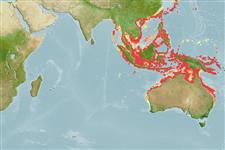>
Eupercaria/misc (Various families in series Eupercaria) >
Nemipteridae (Threadfin breams, Whiptail breams)
Etymology: Scolopsis: Greek, skolex = worm + Greek, opsis = appearance (Ref. 45335).
More on author: Cuvier.
Environment: milieu / climate zone / depth range / distribution range
Ekologi
marina revassocierade; djupintervall 2 - 50 m (Ref. 90102). Tropical; 32°N - 31°S, 90°E - 157°E (Ref. 3810)
Indo-West Pacific: eastern Indian Ocean (Andaman Sea and northwest Australia) to Papua New Guinea, north to the Ryukyu Islands, south to northeastern Australia. This species has been previously reported as Scolopsis dubiosus (a junior synonym of Scolopsis taeniopterus), or misidentified as Scolopsis temporalis.
Size / Vikt / Age
Maturity: Lm ? range ? - ? cm
Max length : 38.0 cm TL hane/ej könsbestämd; (Ref. 90102); common length : 18.0 cm SL hane/ej könsbestämd; (Ref. 3810)
Taggstrålar i ryggfenan (totalt): 10; Mjukstrålar i ryggfenan (totalt): 9; Taggstrålar i analfenan 3; Mjukstrålar i analfenan: 7. Head scales reaching to between anterior margin of eyes and posterior nostrils. Lower limb of preopercle scaly. Antrorse (forward-directed) suborbital spine absent. Pelvic fins long, reaching almost to level of origin of anal fin. Upper lobe of caudal fin a little longer than lower lobe. In larger specimens, lobes produced to form short filamentous extensions in larger specimens. 3 blue stripes on snout; uppermost joining eyes above nostrils. A blue stripe on preopercle behind eye. A blue chevron-shaped stripe running upwards onto opercle from below eye and bending downward towards pectoral-fin base.
Occurs on sand bottoms close to reefs. Often silty habitats (Ref. 48635). Occurs solitary or in small groups. Feeds on small fishes, crustaceans, mollusks and polychaete worms (Ref. 90102). It is parasitised by the monogenean Anoplodiscus hutsonae on the pectoral fins and body surface (Ref. 124057).
Life cycle and mating behavior
Könsmognad | Reproduktion | Lek | Ägg | Fecundity | Larver
Also Ref. 103751.
Russell, B.C., 1990. FAO Species Catalogue. Vol. 12. Nemipterid fishes of the world. (Threadfin breams, whiptail breams, monocle breams, dwarf monocle breams, and coral breams). Family Nemipteridae. An annotated and illustrated catalogue of nemipterid species known to date. FAO Fish. Synop. 125(12):149p. Rome: FAO. (Ref. 3810)
IUCN Red List Status (Ref. 130435)
Threat to humans
Harmless
Human uses
Fiskeri: mindre kommeriell
Ytterligare information
referenserVattenbrukVattenbruksprofilAvelslinjerGenetikElectrophoresesÄrftlighetSjukdomarBehandlingNutrientsMass conversion
MedarbetareBilderStamps, Coins Misc.LjudCiguateraHastighetSimsättGälytaOtolithsHjärnstorlekSyn
Verktyg
Special reports
Download XML
Internet-källor
Estimates based on models
Preferred temperature (Ref.
123201): 24.9 - 29.1, mean 28.2 °C (based on 982 cells).
Phylogenetic diversity index (Ref.
82804): PD
50 = 0.5000 [Uniqueness, from 0.5 = low to 2.0 = high].
Bayesian length-weight: a=0.01905 (0.01050 - 0.03457), b=3.03 (2.88 - 3.18), in cm total length, based on LWR estimates for this species & Genus-body shape (Ref.
93245).
Trofisk nivå (Ref.
69278): 3.5 ±0.5 se; based on diet studies.
Resiliens (Ref.
120179): Mellan, lägsta populationsfördubblingstid 1,4-4,4 år (Preliminary K or Fecundity.).
Fishing Vulnerability (Ref.
59153): Low to moderate vulnerability (28 of 100).
Nutrients (Ref.
124155): Calcium = 46.1 [28.8, 89.1] mg/100g; Iron = 0.601 [0.298, 1.483] mg/100g; Protein = 19 [17, 21] %; Omega3 = 0.143 [0.087, 0.238] g/100g; Selenium = 32 [19, 56] μg/100g; VitaminA = 66.9 [19.2, 186.7] μg/100g; Zinc = 1.16 [0.82, 1.66] mg/100g (wet weight);
